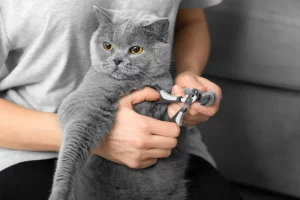Nail trimming is often overlooked in pet care, yet its significance cannot be understated. Overgrown nails can lead to misalignment, affecting a pet’s posture and overall mobility. This connection between nail health and physical well-being is essential for business owners in the pet industry to grasp. Understanding these implications can not only enhance client trust but also elevate the standard of care provided. What are the best practices to guarantee peak nail health for pets?
Key Takeaways
- Regular nail trimming prevents misalignment and ensures healthy posture, impacting pets’ overall well-being and mobility.
- Overgrown nails can lead to discomfort and chronic pain, affecting pets’ social behaviors and activity levels.
- Proper nail care enhances pets’ quality of life, which can influence customer satisfaction in pet-related businesses.
- Understanding the connection between nail care and posture can help business owners educate clients on maintaining their pets’ health.
- Promoting nail trimming services aligns with best practices for pet care, fostering trust and loyalty among pet owners.
The Importance of Nail Care in Pets
Although many pet owners may overlook the significance of nail care, it plays an essential role in maintaining overall pet health and comfort. Regular nail trimming not only prevents discomfort and pain but also directly influences how nail trimming affects pet posture. Overgrown nails can lead to misalignment, resulting in uneven weight distribution, which places stress on joints and muscles. This can manifest in changes to a pet’s gait and posture, ultimately impacting their mobility and overall well-being. Understanding the importance of nail care fosters a sense of community among pet owners, as they collectively endeavor to enhance their pets’ quality of life. By prioritizing nail trimming, owners can guarantee their pets remain comfortable and agile, contributing to a healthier lifestyle.
Understanding Pet Posture and Its Implications
Understanding pet posture is vital, as it serves as an indicator of a pet’s overall health and well-being. Proper posture reflects not only physical fitness but also emotional stability. Pets that stand, sit, or lie down correctly typically exhibit a balance that suggests comfort and strength. Conversely, poor posture can indicate pain, discomfort, or underlying health issues. Observing how a pet carries itself can reveal insights into its mental state and physical condition. Additionally, a pet’s posture affects its interactions with owners and the environment, influencing social behaviors and activity levels. Accordingly, understanding pet posture is essential for pet owners, as it fosters a deeper connection and facilitates timely interventions when health concerns arise.
How Nail Trimming Affects Pet Posture
Proper nail care plays a significant role in maintaining a pet’s overall posture and comfort. Overgrown nails can lead to an unnatural stance, causing misalignment in the joints and spine. This misalignment may result in discomfort, pain, or even chronic mobility issues. When pets walk on long nails, they may shift their weight awkwardly to avoid pressure, further exacerbating posture-related problems. Regular trimming helps guarantee that pets stand and move correctly, promoting healthy alignment and reducing the risk of injuries. Additionally, a comfortable posture enhances the pet’s quality of life, allowing them to engage in playful activities and social interactions. Understanding how nail trimming affects pet posture is essential for fostering long-term health and well-being in our beloved companions.

Common Nail Trimming Mistakes to Avoid
Trimming a pet’s nails can be a straightforward task, yet many owners make critical mistakes that jeopardize both the process and the pet’s well-being. Understanding these common pitfalls is essential for fostering a healthy bond between pet and owner.
- Neglecting to check the nail length, leading to discomfort and potential injury.
- Using improper tools, which can cause pain or fear during the trimming process.
- Forcing the pet into a stressful situation, damaging trust and complicating future trims.
Best Practices for Maintaining Healthy Pet Nails
Maintaining healthy nails is vital for a pet’s overall well-being and comfort. Regular nail trimming helps prevent discomfort, pain, and potential posture issues that may arise from overgrown nails. Pet owners should establish a consistent schedule for nail care, ideally every 3-4 weeks, to guarantee nails remain at a manageable length. Utilizing proper tools, such as clippers designed specifically for pets, can minimize stress during the process. Additionally, rewarding pets with treats and positive reinforcement creates a more enjoyable experience. Monitoring the nails for signs of splitting or infection is also significant. By understanding how nail trimming affects pet posture, owners can foster a supportive environment that enhances their pet’s quality of life and overall health.
Frequently Asked Questions
Can Nail Trimming Reduce My Pet’s Risk of Injury?
Nail trimming can greatly reduce a pet’s risk of injury. Well-maintained nails improve stability and balance, preventing slips and falls. Regular grooming fosters overall health, enhancing a pet’s well-being and contributing to a safer environment.
How Often Should I Trim My Pet’s Nails?
Regular nail trimming is essential for pets, typically every 3-4 weeks. This schedule helps maintain proper posture and mobility, reducing discomfort and injury risk. Consistent care fosters a healthier, happier life for beloved companions.
What Tools Are Best for Nail Trimming?
When considering nail trimming, effective tools include clippers, grinders, and scissors. Each serves unique purposes, catering to different pet needs. Ensuring comfort and precision fosters a positive experience, enhancing overall wellbeing and owner-pet relationships.
Are There Signs My Pet Needs a Nail Trim?
Signs that a pet needs a nail trim include excessive clicking on hard surfaces, difficulty walking, and visible overgrowth. Observing these indicators can help guarantee the pet’s comfort and prevent potential posture-related issues.
Can Improper Nail Trimming Cause Behavioral Issues?
Improper nail trimming can lead to discomfort and pain in pets, potentially resulting in behavioral issues such as irritability or reluctance to engage. Understanding these consequences fosters a compassionate approach to pet care and owner-pet relationships.
Conclusion
To summarize, understanding the critical relationship between nail trimming and pet posture is essential for business owners in the pet industry. Regular nail care not only promotes proper alignment and mobility but also enhances the overall well-being of pets. By educating clients on the significance of this practice, businesses can establish themselves as trusted authorities in pet health. Ultimately, fostering a culture of proactive nail care will lead to happier, healthier pets and stronger customer loyalty.
You May Also Like To Read:





